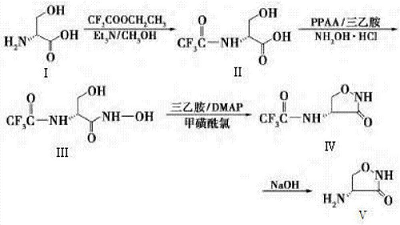Do you know what the main role of cycloserine is?
Cycloserine Cs is a scientific name for D--4-amino-3-tetrahydroisoxazolone. Molecular formula C3H6N2O2, molecular weight 102.09. This product has a broad-spectrum antibacterial effect, inhibits most Gram-positive and Gram-negative bacteria, but has a weak antibacterial effect, and has a good inhibitory effect on Mycobacterium tuberculosis. Its mechanism of action is to inhibit and interfere with bacterial cell wall. Synthesis. Cycloserine has a good inhibitory effect on Mycobacterium tuberculosis. Because bacteria are not easy to develop resistance, it is mainly used for the treatment of drug-resistant Mycobacterium tuberculosis infection. In addition, D-cycloserine is a special regulator of excitatory amino NMDA receptors in the central nervous system, and it also has a good adjuvant effect on the treatment of mental phobia, depression, schizophrenia and other mental diseases. It is also an important intermediate for the synthesis of atypical β-lactam antibiotic Lactivicin.

Cycloserine has been the main drug for replicating chemotherapy before the advent of RFP. Cycloserine itself is not easy to produce drug resistance, it is also effective against drug-resistant tuberculosis, and it can also prevent bacteria from being resistant to propyl isoxanthamide (Pto). One of the key drugs for the treatment of multidrug-Resistant Tuberculosis (MDR-TB), but the domestic oral preparation of cycloserine has been lacking. In recent years, MDR-TB is increasing day by day. The first-line drugs of isoniazid and rifampic are often unable to meet the needs of clinical treatment. The low resistance rate of cycloserine to tuberculosis is valued. The World Health Organization recommends the use of cycloserine for the treatment of MDR- T. Therefore, D-cycloserine has broad application prospects and huge market demand.
[Physical and chemical properties]
Cycloserine is a white or light yellow crystalline powder, which is hygroscopic, odorless and slightly bitter. Soluble in water, soluble in ethanol, slightly soluble in chloroform, ether. The 10% aqueous solution has a pH of 5.7 to 6.3. It is stable when the pH of the aqueous solution is 6-8.
[indications]
Cycloserine is clinically used for drug-resistant Mycobacterium tuberculosis to cause infection. It is often used in combination with other anti-tuberculosis drugs such as isoniazid, streptomycin and p-aminosalicylic acid, and can also be used for urinary tract infection caused by Escherichia coli.
[Pharmacological action and mechanism of action]
Cycloserine is a second-line anti-tuberculosis drug. The antibacterial spectrum is broad, and it has inhibitory effects on a variety of Gram-positive and Gram-negative bacteria, but its effect is weaker than streptomycin and isoniazid. Its antibacterial mechanism is to interfere with the synthesis of bacterial cell walls. The concentration of anti-tuberculosis bacteria is 5-20 mg/L. No cross-resistance with other anti-tuberculosis drugs. This product is not easy to produce drug resistance.
【Pharmacokinetics】
Oral absorption of cycloserine is rapid, and the peak plasma concentration is reached after oral administration for 3 to 4 hours. Oral administration of 0.25g peaked at an average of 4mg/L, repeated medication, can reach a higher peak. The plasma half-life is 10 hours. After absorption, it is distributed in whole body tissues and body fluids, and can diffuse into the fetal circulation and cerebrospinal fluid, ascites, and milk. Most of them are excreted by the kidneys in the original form, and those with renal insufficiency are prone to accumulate poisoning, and a small amount is discharged from the feces.
【medicine interactions】
1, taking ethionamide at the same time can increase the neurotoxicity of this product.
2, alcohol and this product have incompatibility, especially when taking this product in large quantities, alcohol can increase the possibility and risk of seizures.
3, the application of this product and isoniazid can increase the incidence of central nervous system toxicity, such as dizziness or lethargy. The dose to be administered must be adjusted and central nervous system toxicity should be closely monitored.
【Adverse reactions】
1. Mainly for the central nervous system toxic reaction, can cause mental confusion, depression, behavioral changes, and sometimes sudden suicide, so if there is personality change and excessive depression, it should be discontinued and strictly guarded.
2. Patients with original epilepsy or mental illness are hanged.
Send inquiry online For more product information and prices
(Pharmaceutical Ingredients Manufacturer & Supplier & Exporter.)
After sending the online inquiry, we will reply you as soon as possible, if not get any response on time please contact us by Tel or Email. —— Green Stone Swiss
Email: sales@raw-pharmaceutical-materials.comTel: +86 592 5365887
WhatsApp: +86 189 6515 7632
Send inquiry online:

